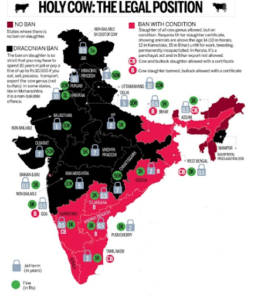In news– Assam Cattle Preservation Act, 2021 has led to an acute beef crisis in Meghalaya recently.
Key provision of the act-
- This Act replaced the Assam Cattle Preservation Act, 1950, on the ground that the latter lacked sufficient legal provisions to regulate the slaughter, consumption and transportation of cattle.
- The 2021 Act bars sale and purchase of beef or beef products in areas “predominantly inhabited by Hindu, Jain, Sikh and other non beef-eating communities”, or “within a radius of 5 km” of any temple or sattra (Vaishnavite monasteries).
- The Act, ostensibly passed to check cattle smuggling to Bangladesh, prohibits inter-state transport of cattle to and from Assam without valid documents.
- The legislation was initially meant to be applicable to all cattle (cows, bulls, bullocks, buffaloes). Before it became a law, buffaloes were removed from the definition.
- While it prohibits slaughter of a cow under any circumstances, other cattle can be slaughtered subject to a “fit for slaughter” certificate.
- The law gives authorities the power to “enter and inspect any premises” on the basis of suspicion.
- It provides for a minimum jail term of three years (extendable up to eight years) and a Rs 3 lakh fine (with the upper limit Rs 5 lakh). For repeat offenders, the punishment will be doubled.
The amendments-
- The main amendments include a change in the transport permissions to cattle within the state and two new provisions that provide more teeth to the police.
- The original legislation had prohibited inter-district movement of cattle within Assam without valid documents.
- The amendment now allows movement from one district to another, provided these do not border Bangladesh, and provided those transporting the cattle are registered under the Animal Husbandry and Veterinary Department, and have permits to transport the cattle for bonafide agricultural or animal husbandry purposes or for trade.
- The amendments empower the police to enter the house of an accused, search and seize properties if they have a “prima facie reason to believe” that the properties have been acquired in the last six years with money earned from illegal cattle trade.
- This provision also places the burden of proof on the accused, saying: “Provided that the burden of proving that the property so attached or seized has not been illegally acquired through sale or transportation of cattle in violation of any of the provision under this Act, shall be on the person affected”.
- Another amendment allows for the sale of seized vehicles, boats and vessels through “public auction” after being produced before the appropriate court.
Other states in India that have banned cow slaughter-
- There are strictest laws in Delhi, Gujarat, Haryana, Himachal Pradesh, Jammu and Kashmir, Ladakh, Punjab, Rajasthan, Uttar Pradesh and Uttarakhand, where the slaughter of cow and its progeny, including bulls and bullocks of all ages, is completely banned.
- States such as Kerala, Arunachal Pradesh, Meghalaya, Nagaland, Sikkim, Tripura, Manipur and Mizoram have no laws prohibiting cow slaughter.
- In India, livestock provides livelihood to two-third of rural community and also provides employment to about 8.8 % of the population in India.
- Livestock sector contributes 4.11% of GDP and 25.6% of total Agriculture GDP.

- As per the 20th livestock census, the total number of cattle in the country is 192.49 million in 2019 showing an increase of 0.8 % over previous Census.
- The Female Cattle (Cows population) is 145.12 million, increased by 18.0% over the previous census (2012).
Further reading: https://journalsofindia.com/livestock-census-2/














